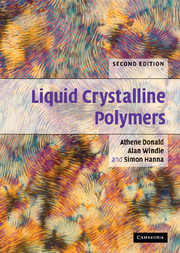Book contents
- Frontmatter
- Contents
- Preface to first edition
- Preface to second edition
- Part I Fundamentals
- 1 Liquid crystalline polymers: a brief history
- 2 Terminology and concepts
- 3 Stability of liquid crystalline polymers
- 4 Theories of liquid crystallinity in polymers
- 5 Local order and classification
- 6 Distortions and defects
- 7 Biological liquid crystalline polymers
- 8 Flow and applied fields
- Part II Applications
- List of symbols
- Molecule index
- General index
2 - Terminology and concepts
from Part I - Fundamentals
Published online by Cambridge University Press: 08 January 2010
- Frontmatter
- Contents
- Preface to first edition
- Preface to second edition
- Part I Fundamentals
- 1 Liquid crystalline polymers: a brief history
- 2 Terminology and concepts
- 3 Stability of liquid crystalline polymers
- 4 Theories of liquid crystallinity in polymers
- 5 Local order and classification
- 6 Distortions and defects
- 7 Biological liquid crystalline polymers
- 8 Flow and applied fields
- Part II Applications
- List of symbols
- Molecule index
- General index
Summary
While both polymer science and liquid crystalline science are multidisciplinary fields in their own right, their combination in the study of liquid crystalline polymers (LCPs) creates a subject area which requires an unusually wide range of background expertise. In preparing this book, we recognise that the subject is demanding in that its full appreciation will almost certainly involve the reader in some unfamiliar terminology and new concepts. This chapter is included in order to lighten that task. It provides a number of background topics arranged alphabetically which can be referred to as required. Almost inevitably, some of the sections will appear rather banal where they correspond to areas in which the reader is already knowledgeable, however, that is perhaps a small price to ensure that the text is accessible to all who have taken some branch of physical science at university level. This type of arrangement also relieves the main chapters of excessive background material, and, where possible, key terms used in the text are explained more fully here.
Amphiphilic Literally this means ‘both-loving’. It describes a molecule which has one end which is hydrophobic, and the other end hydrophilic (and often charged). The noun derived from this is an amphiphile, and many small molecule amphiphiles form liquid crystalline phases, because when placed in water they have an inherent tendency to self-assemble. Examples include soap (which will form a layered smectic phase) and lipids – natural molecules with a polar head-group and one or two alkyl chains as the hydrophobic end, which self-assemble into cell membranes.
- Type
- Chapter
- Information
- Liquid Crystalline Polymers , pp. 11 - 67Publisher: Cambridge University PressPrint publication year: 2006

